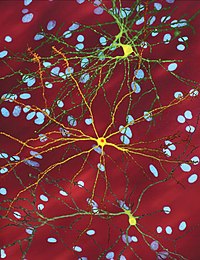
Photo from wikipedia
Background: Diagnosis of manifest Huntington disease (HD) is based primarily on motor symptoms, but premanifest HD (preHD) is often associated with subtle cognitive decline. The Loewenstein–Acevedo Scales for Semantic Interference… Click to show full abstract
Background: Diagnosis of manifest Huntington disease (HD) is based primarily on motor symptoms, but premanifest HD (preHD) is often associated with subtle cognitive decline. The Loewenstein–Acevedo Scales for Semantic Interference and Learning (LASSI–L) is a validated verbal learning test that can be used to detect early cognitive decline. Objective: To determine the utility of the LASSI–L for detecting early cognitive decline in individuals with preHD and to compare the results of the LASSI–L with those of commonly used neuropsychological tests in HD. Method: We administered the LASSI–L to 13 individuals with preHD and 13 healthy controls matched for age, sex, and education as part of a longitudinal study of disease progression. For comparison purposes, we administered the Mini-Mental State Examination; Stroop Color and Word Test; Symbol Digit Modalities Test; Trail-Making Test, Parts A and B; and category fluency (animals) task. Results: Five of the seven sections on the LASSI–L captured group differences: Proactive Semantic Interference (PSI; P < 0.001), Failure to Recover From PSI (P = 0.038), Retroactive Semantic Interference (RSI; P = 0.013), Delayed Recall (P < 0.001), and B1 Cued Recall Intrusions (P = 0.036). Using a false discovery rate of <0.05, PSI, RSI, and Delayed Recall remained significant. Conclusion: The LASSI–L is a sensitive instrument for detecting early interference effects in individuals with preHD that outperforms commonly used neuropsychological tests. The LASSI–L could be a useful addition to clinical and research protocols involving individuals with preHD.
Journal Title: Cognitive and Behavioral Neurology
Year Published: 2023
Link to full text (if available)
Share on Social Media: Sign Up to like & get
recommendations!